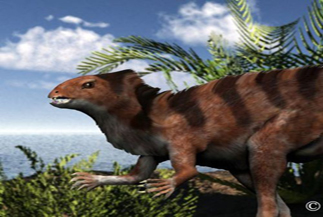
Manidens Dinosaur is a small, enigmatic dinosaur that lived during the Late Jurassic period, approximately 160 million years ago. It belongs to the family Heterodontosauridae, a group of small herbivorous dinosaurs known for their unique dental characteristics. Manidens fossils have been discovered in Argentina, shedding light on the diversity of dinosaurs during this time.
Manidens was a relatively small dinosaur, estimated to have been about 1 to 1.5 meters (3 to 5 feet) in length. Its body was compact and low to the ground, with short limbs that were adapted for walking on all fours. The skeletal structure of Manidens suggests that it may have been a facultative biped, capable of both quadrupedal and bipedal locomotion. The most distinctive feature of Manidens is its teeth. This combination of tooth types suggests that Manidens had a diverse diet, capable of feeding on a range of plant material. The front teeth were likely used for nipping and cropping vegetation, while the cheek teeth were used for grinding and chewing.
Manidens Facts :
| Name: | Manidens Dinosaurs |
| Size: | 1-1.5 meters |
| Main Facts: | Manidens is a small, enigmatic dinosaur that lived during the Late Jurassic period, approximately 160 million years ago. |
Despite its small size, Manidens may have been equipped with some form of defense. Some fossils show evidence of bony structures resembling spines or horns on its back, possibly used for protection against predators or for display purposes. However, due to the limited fossil record, the exact nature and function of these structures remain uncertain. The discovery of Manidens fossils has provided valuable insights into the evolution and diversity of herbivorous dinosaurs during the Late Jurassic. Its unique dental characteristics offer clues about the dietary adaptations and ecological niches occupied by these small dinosaurs.
However, much about Manidens and its behavior, reproduction, and overall biology remains speculative due to the scarcity of fossils. Scientists continue to study new discoveries and analyze existing fossils to unravel the mysteries surrounding this enigmatic dinosaur and its place within the evolutionary history of dinosaurs.